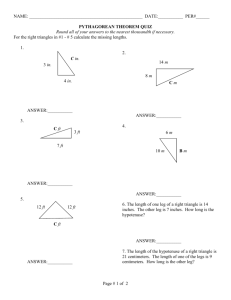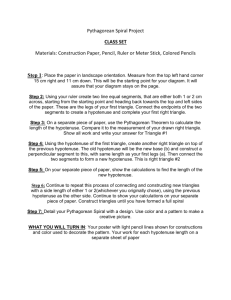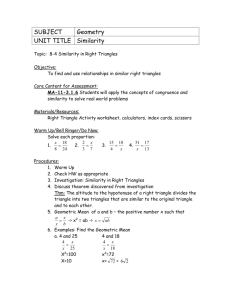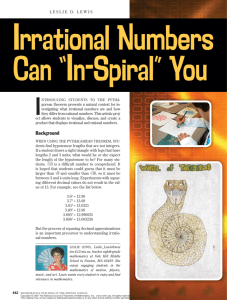Wheel of Theodorus Math Art Project Assignment
advertisement
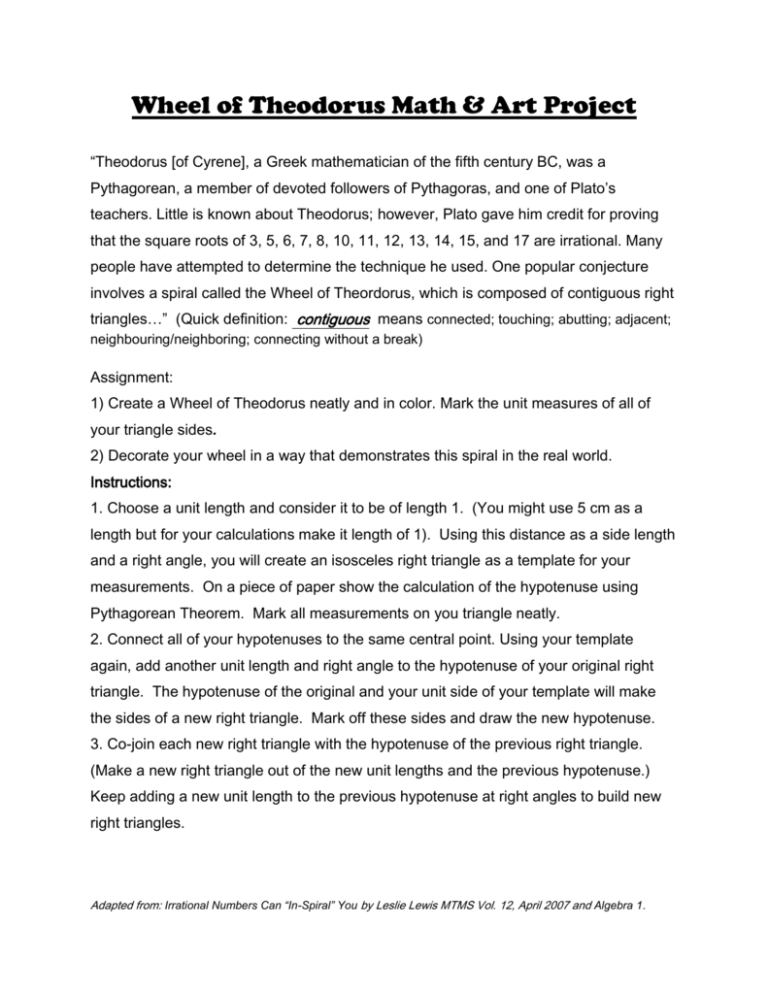
Wheel of Theodorus Math & Art Project “Theodorus [of Cyrene], a Greek mathematician of the fifth century BC, was a Pythagorean, a member of devoted followers of Pythagoras, and one of Plato’s teachers. Little is known about Theodorus; however, Plato gave him credit for proving that the square roots of 3, 5, 6, 7, 8, 10, 11, 12, 13, 14, 15, and 17 are irrational. Many people have attempted to determine the technique he used. One popular conjecture involves a spiral called the Wheel of Theordorus, which is composed of contiguous right triangles…” (Quick definition: contiguous means connected; touching; abutting; adjacent; neighbouring/neighboring; connecting without a break) Assignment: 1) Create a Wheel of Theodorus neatly and in color. Mark the unit measures of all of your triangle sides. 2) Decorate your wheel in a way that demonstrates this spiral in the real world. Instructions: 1. Choose a unit length and consider it to be of length 1. (You might use 5 cm as a length but for your calculations make it length of 1). Using this distance as a side length and a right angle, you will create an isosceles right triangle as a template for your measurements. On a piece of paper show the calculation of the hypotenuse using Pythagorean Theorem. Mark all measurements on you triangle neatly. 2. Connect all of your hypotenuses to the same central point. Using your template again, add another unit length and right angle to the hypotenuse of your original right triangle. The hypotenuse of the original and your unit side of your template will make the sides of a new right triangle. Mark off these sides and draw the new hypotenuse. 3. Co-join each new right triangle with the hypotenuse of the previous right triangle. (Make a new right triangle out of the new unit lengths and the previous hypotenuse.) Keep adding a new unit length to the previous hypotenuse at right angles to build new right triangles. Adapted from: Irrational Numbers Can “In-Spiral” You by Leslie Lewis MTMS Vol. 12, April 2007 and Algebra 1. 4. When you get to the stage where your right triangles will overlap previous right triangles, draw your hypotenuse toward the center of the spiral, but do not mark over the previous drawings. 5. Label your figure with all dimensions of all right triangles. (Label all triangle legs and hypotenuses with the appropriate lengths.) Write your labels using radicals, unless they can be simplified to rational numbers. If a hypotenuse has a length that is a rational number, demonstrate that you recognize this fact. (For example, since √4 = 2. show this on your project.) 6. Include a title for your picture. 7. On the front of your picture, include your signature and the date. 8. Make sure your project is neat. Use color, unless you mean to emphasize contrast by using black and white. 9. Attach a lined sheet of paper, containing your calculations to find the lengths of segments (using the Pythagorean Theorem and showing all steps) for your first 8 triangles, to your art. 10. Answer the following questions on the sheet of paper which shows your calculations: a) What patterns do you see in the hypotenuse lengths? b) The Wheel of Theodorus can go on forever. List the side lengths of the next 6 triangles (without using the Pythagorean Theorem. c) Find the areas of the first five triangles in the wheel. (Show the area formula and all steps to solve each problem.) What pattern(s) do you observe? d) Suppose you continue adding triangles to the wheel. Which triangle will have a hypotenuse length of 5 units? 11. Include a written reflection that explains how you came to choose your design and an explanation of its existence in the real world. Include any issues you encountered in your design process. Explain what was easy and what was difficult, any problems you encountered, and how you solved them. Discuss the aspects of the design or process of which you are the most proud. Adapted from: Irrational Numbers Can “In-Spiral” You by Leslie Lewis MTMS Vol. 12, April 2007 and Algebra 1.

